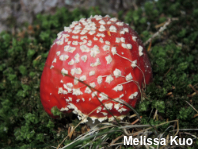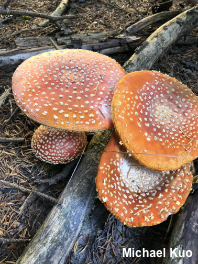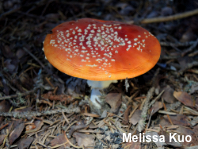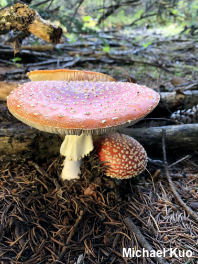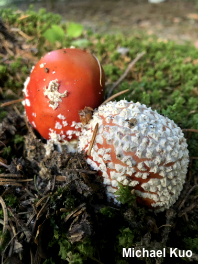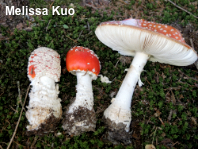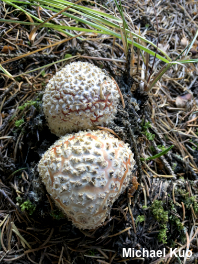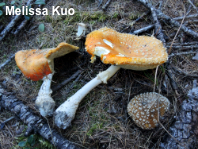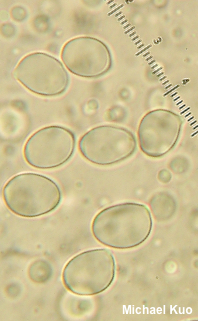| Major Groups > Gilled Mushrooms > Pale-Spored > Amanita > Amanita muscaria var. muscaria |

|
Amanita muscaria var. muscaria [ Basidiomycota > Agaricales > Amanitaceae > Amanita . . . ] by Michael Kuo This has got to be the world's most well-known mushroom. I mean, it has its own universal emoji, easily deployed on virtually any smart phone on the planet! LOL OMG However, if you look closely, the Amanita muscaria emoji isn't really very accurate. For one thing, its stem is too short. But more importantly, it's missing the ring and distinctive muscaria stem base, which features concentric bands of felty whitish volval tissue. The true Amanita muscaria, originally described by Linnaeus before the American and French revolutions, is described and illustrated on this page. Its name is officially Amanita muscaria var. muscaria, and its natural range includes Europe, Asia, and western Alaska. It is absent from most of North America, where it is replaced by Amanita muscaria var. flavivolvata (with a similar red cap but with warts and veil remnants that are yellow when young), Amanita muscaria var. guessowii (with an orange to yellow cap), Amanita muscaria var. persicina (with a peach-colored cap), and Amanita muscaria var. alba (with a white cap). Description: Ecology: Mycorrhizal with conifers (primarily pines and spruces) and some hardwoods (primarily birch); summer and fall; fairly widely distributed in Europe and Asia; recorded from North America in western Alaska; introduced in various locations with eucalyptus, including Australia and South America. The illustrated and described collections are from Finland and Italy. Cap: 7–21 cm across; oval or round at first, becoming convex, then broadly convex to flat in age; bald and a little sticky underneath numerous small, cottony, pyramid-shaped, whitish warts; deep to bright red, fading to orangish red or dull orange; the margin sometimes becoming broadly lined for about 1 cm at maturity. Gills: Free from the stem or nearly so; close or crowded; short-gills frequent; white. Stem: 7–18 cm long; 2–3.5 cm thick; more or less equal above a swollen base; bald or a little shaggy; white; with a high, skirtlike ring; with concentric bands of felty, often-recurved universal veil material at the top of the bulb and/or on the lower stem. Flesh: White throughout; unchanging when sliced. Odor: Not distinctive. Spore Print: White. Microscopic Features: Spores 10–13 x 8–9 µm; broadly ellipsoid; smooth; hyaline in KOH; inamyloid. Basidia 4-sterigmate; clamped at the base. Hymenial cystidia not found. Pileipellis an ixocutis of smooth, hyaline hyphae 2–4 µm wide. REFERENCES: (Linnaeus, 1753) de Lamarck, 1783. (Fries, 1821; Phillips, 1981; Breitenbach & Kränzlin, 1995; Neville & Poumarat, 2004; Geml et al., 2006; Kibby, 2006; Nonis, 2007; Laursen & Seppelt, 2009; Buczacki, 2012; Gminder & Böhning, 2017; Vesterholt, 2018; Tulloss, continuously updated.) Herb. Kuo 09221804. This site contains no information about the edibility or toxicity of mushrooms. |
© MushroomExpert.Com |
|
Cite this page as: Kuo, M. (2019, October). Amanita muscaria var muscaria. Retrieved from the MushroomExpert.Com Web site: http://www.mushroomexpert.com/amanita_muscaria_muscaria.html |
